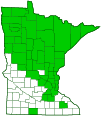Gray Wolf
(Canis lupus)
Conservation • Description • Habitat • Ecology • Distribution • Taxonomy
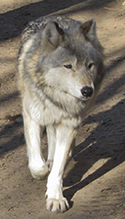
Conservation Status
IUCN Red List
LC - Least Concern
NatureServe
N4 - Apparently Secure
S3 - Vulnerable
Federal
Threatened
In 1966 Congress passed the Endangered Species Preservation Act. A year later the Gray Wolf was classified as endangered. At that time only a few hundred remained in extreme northeastern Minnesota and a small number on Isle Royale, Michigan. In 1978 it was reclassified as threatened.
In 2012 Gray Wolf was delisted due to a significant increase in their numbers and their range. The delisting was controversial. In 2014 a federal judge forced the reinstatement of the wolf, and it was relisted as threatened. In January 2021 it was again removed from the protected species list.
Following a court order on 2/10/2022, “…gray wolves in the contiguous 48 states and Mexico – with the exception of the Northern Rocky Mountain population – are now protected under the Endangered Species Act (ESA) as threatened in Minnesota and endangered in the remaining states.”. The court order has been appealed by a number of parties. The appeals are in abeyance until 2/2/2024, when the USFWS "… intends to submit to the Office of the Federal Register a proposed rule concerning the listing status of gray wolves in the lower-48 United States under the Act.”
Minnesota
Delisted
In 1984, the Gray Wolf was classified as threatened in Minnesota only. Due to continued increase in their numbers it was reclassified as special concern in 1996 and delisted in 2013.
Description
Eastern Wolf (C. l. lycaon), also called timber wolf, is relatively small, with males weighing on average 67 pounds and females 53 pounds. They have longer ears and a narrower snout. They tend to be mottled gray.
Great Plains Wolf (C. l. nubilus) is much larger, with males weighing on average 100 pounds. They have shorter ears and a broader snout. They can vary from black to white, though most are gray.
Great Lakes Boreal Wolf (C. l. lycaon x C. l. nubilus) mostly has intermediate traits, grading from more C. l. lycaon-like in the east to more C. l. nubilus-like in the west.
Size
Total length: 59″ to 62″
Tail: 15½″ to 18″
Sign
Similar Species
Habitat
Any type of habitat
Ecology
Behavior
Lifespan
Usually 6 to 8 years
Life Cycle
Food
Mostly White-tailed Deer, but also beaver, other mammals, and wild fruits.
Distribution |
||
|
Sources Biodiversity occurrence data published by: Minnesota Biodiversity Atlas (accessed through the Minnesota Biodiversity Atlas Portal, bellatlas.umn.edu, 12/14/2025). Minnesota DNR; The Nature Conservancy; U.S. Fish & Wildlife Service; Distribution and Abundance of Wolves in Minnesota, 2012-13, John Erb and Barry Sampson, Minnesota Department of Natural Resources Minnesota DNR; The Nature Conservancy; U.S. Fish & Wildlife Service; Distribution and Abundance of Wolves in Minnesota, 2017-18, John Erb, Carolin Humpal, and Barry Sampson, Minnesota Department of Natural Resources Timm, R. M. 1975. Distribution, natural history, and parasites of mammals of Cook County, Minnesota. Occasional Papers, Bell Museum of Natural History, University of Minnesota 14:1–56. Hazard, Evan B. 1982. The Mammals of Minnesota. University of Minnesota Press, Minneapolis, Minnesota. 280 pp. |
|
| 12/14/2025 | ||
Occurrence |
||
Locally common |
||
Taxonomy
Class
Subclass
Theria
Infraclass
Placentalia (Placental Mammals)
Magnorder
Boreoeutheria
Superorder
Laurasiatheria (Ungulates, Carnivorans, and Allies)
Order
Carnivora (Carnivorans)
Suborder
Caniformia (Dog-like Carnivores)
Infraorder
Cynoidea
Family
Canidae (Canids)
Subfamily
Caninae
Tribe
Canini
Genus
Canis (Wolves and Dogs)
Subordinate Taxa
Debate continues about whether there are different species of gray wolves in the world. In 2000, Wilson et al proposed designating the Eastern Wolf as a separate species, Canis lycaon. This proposal was not widely adopted.
Eastern Wolf (C. l. lycaon), also called Timber Wolf, was originally found in the northeastern corner of the state. Great Plains WWolfolf (C. l. nubilus) was originally found in the western counties, with hybrids occurring between the two. The dispersal ranges of the two subspecies overlap considerably and much hybridization occurs. The original genetic purity of the eastern and western population remains unknown. While is likely that genetically pure populations occur at the ends of the respective Minnesota ranges, the current Minnesota population consists mostly of hybrids of the two subspecies, known informally as Great Lakes Boreal Wolf, with more C. l. nubilus traits in the west and more C. l. lycaon traits in the east.
Alaskan tundra Wolf (Canis lupus tundrarum)
Alexander Archipelago Wolf (Canis lupus ligoni)
Arabian Wolf (Canis lupus arabs)
Arctic Wolf (Canis lupus arctos)
Baffin Island Wolf (Canis lupus manningi)
Bernard’s Wolf (Canis lupus bernardi)
British Columbia Wolf (Canis lupus columbianus)
Cascade Mountain Wolf (Canis lupus fuscus)
dingo (Canis lupus dingo)
domestic dog (Canis lupus familiaris)
eastern Wolf (Canis lupus lycaon) ![]()
Eurasian Wolf (Canis lupus lupus)
Florida black Wolf (Canis lupus floridanus)
Gansu Wolf (Canis lupus filchneri)
Great Lakes boreal Wolf (Canis lupus lycaon × Canis lupus nubilus) ![]()
Great Plains Wolf (Canis lupus nubilus) ![]()
Greenland Wolf (Canis lupus orion)
Gregory’s Wolf (Canis lupus gregoryi)
Hokkaidō Wolf (Canis lupus hattai)
Honshū Wolf (Canis lupus hodophilax)
Hudson Bay Wolf (Canis lupus hudsonicus)
Indian Wolf (Canis lupus pallipes)
Kenai Peninsula Wolf (Canis lupus alces)
Labrador Wolf (Canis lupus labradorius)
Mackenzie River Wolf (Canis lupus mackenzii)
Manitoba Wolf (Canis lupus griseoalbus)
Mexican Wolf (Canis lupus baileyi)
Mogollon Mountain Wolf (Canis lupus mogollonensis)
Newfoundland Wolf (Canis lupus beothucus)
Northern Rocky Mountains Wolf (Canis lupus irremotus)
Northwestern Wolf (Canis lupus occidentalis)
Red Wolf (Canis lupus rufus)
Southern Rocky Mountains Wolf (Canis lupus youngi)
Steppe Wolf (Canis lupus campestris)
Texas Wolf (Canis lupus monstrabilis)
Tibetan woolly Wolf (Canis lupus chanco)
tundra Wolf (Canis lupus albus)
Vancouver Island Wolf (Canis lupus crassodon)
Yukon Wolf (Canis lupus pambasileus)
Synonyms
Canis furlongi
Canis nubilus
Canis pambasileus
Canis petrolei
Canis tundrarum
Lupus gigas
Lupus lupus
Common Names
Gray Wolf
Wolf
Visitor Photos
Share your photo of this mammal.
This button not working for you?
Simply email us at info@MinnesotaSeasons.com.
Attach one or more photos and, if you like, a caption.
Mike Poeppe |
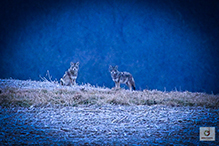 |
Coyote/wolf I found this pair about 6 miles south of Houston on Thursday morning. I am not sure if they are wolves or coyote? They were out about 1/2 mile and sure looked big for out that far. |
Kim |
 |
walking down country road like it owned it. Never stopped never looked around just kept going this was at 645 am |
Ramona Abrego |
||
Captive – Wildlife Science Center |
||
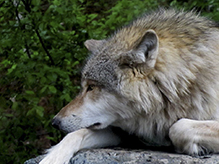 |
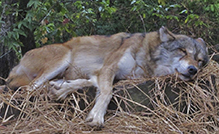 |
|
 |
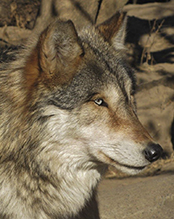 |
|
 |
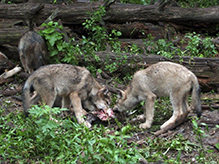 |
|
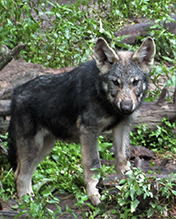 |
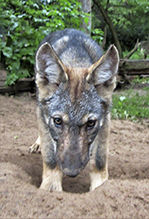 |
|
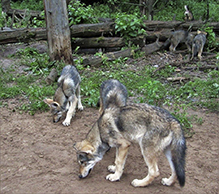 |
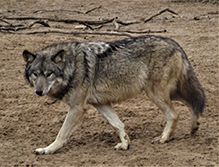 |
|
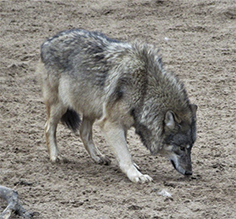 |
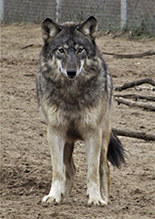 |
|
 |
||
MinnesotaSeasons.com Photos
|

Slideshows
Gray Wolf
Craig A. Mullenbach

Visitor Videos
Share your video of this mammal.
This button not working for you?
Simply email us at info@MinnesotaSeasons.com.
Attach a video, a YouTube link, or a cloud storage link.
Other Videos
The Wolves
Krecika1988
Timberwolf (Canis lupus lycaon) [HQ]
Kanal von AnimalPlanetH
Wolves, Ely Minnesota 2008
marinacastillo

Visitor Sightings
Report a sighting of this mammal.
This button not working for you?
Simply email us at info@MinnesotaSeasons.com.
Be sure to include a location.
Mike Poeppe
12/22/2023
Minnesota Seasons Sightings
Nemadji State Forest





